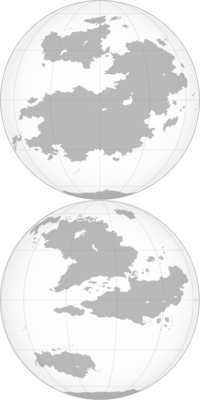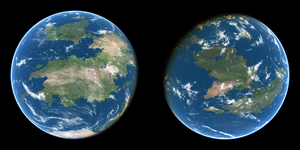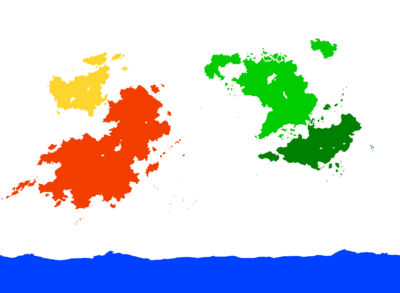Kylaris: Difference between revisions
No edit summary |
mNo edit summary |
||
| Line 14: | Line 14: | ||
| satellite_of = | | satellite_of = | ||
| mean_radius = 0.091 {{wp|Jupiter|''R''<sub>J</sub>}} (6,371 km) | | mean_radius = 0.091 {{wp|Jupiter|''R''<sub>J</sub>}} (6,371 km) | ||
| surface_area = | | surface_area = 559,277,752 km<sup>2</sup> | ||
| volume = | | volume = | ||
| density = | | density = | ||
Revision as of 01:39, 28 February 2023
 | |
| Orbital characteristics | |
|---|---|
| Eccentricity | ~0 |
| 365.256 days | |
| Physical characteristics | |
Mean radius | 0.091 RJ (6,371 km) |
| 559,277,752 km2 | |
| Mass | 0.003 MJ (5.97 x 1024 kg) |
| 9.81 m/s2 (avg) | |
| Atmosphere | |
Surface pressure | 101 kPa (1 atm) |
Kylaris, commonly known as earth, is a rocky planet in the Solaris star system. It completes an orbit around Solaris approximately every 365.2422 calendar days (rotations about its axis); from the perspective of its North Pole it, like most celestial bodies in the star system, orbits counterclockwise. It is spherical with a slight bulge at the equator owing to its rotation, which is slightly tilted compared to its orbital axis with respect to the sun, and it has one planetoid moon. Its axis of rotation produces seasons, as it is titled in respect to the planet's orbital plane. The planet is notable for being the only known location to harbor, at any time, life.
The planet is believed to have formed several billion years ago from the heavier elements in the accretion disk of the sun; the presence of these elements mean that Solaris is at youngest a second-generation star. Distinct layers formed over time as accretion slowed and the planet cooled. The planet has a metallic core, which creates a magnetic field around the planet. This is surrounded by a mostly liquid mantle composed of various metallic and nonmetallic elements, silicon being the most common. The outermost layer is the solid crust, or lithosphere, which is thin but encompasses the entire planet. It is composed of generally lighter materials than the mantle. The planet's active tectonics are highly influential on its topography and biosphere.
The atmosphere is primarily nitrogen with a significant fraction of oxygen; most other components of the atmosphere, including argon and carbon dioxide, are trace. The atmosphere can be divided into layers depending on altitude and is thick enough to burn up the vast majority of objects which fall into it.
The majority of Kylaris's surface is uninhabitable. Three-quarters is covered by oceans and other bodies of water. Of the quarter that is land, nearly half is uninhabitable desert, mountains, or ice caps. Only an estimated one-eighth of Kylaris's surface is considered habitable by humans. Although the range of permanent human settlement is limited by geography, modern technology has allowed humans to establish small outposts in even the most challenging environments. Suqquirut in George Ruset Land is the northernmost permanent settlement in the world, and the southernmost is the South Pole Station located at the South Pole on the continent of Glacia.
All known life is native to the planet, with rough estimates of millions of species and octillions of individual lifeforms. Life is thought to have been present for around half of the planet's existence. The biosphere is believed to be constrained to the crust, the lower atmosphere, and possibly the upper mantle. The only species known to have exited the atmosphere is humans, who are generally considered the dominant species.
Etymology
The commonly accepted Estmerish name for the planet, Kylaris, is a Piraean loanword, from Κυλάρις, kylaris. Kylaris was the name of the Piraean goddess of nature. She was adopted into the Solarian pantheon where she was also known as Terra, resulting in the use of terra as a name for the planet in Solarian and its derivative languages.
The planet is commonly referred to as earth, another modern Estmerish word, in media and conversation. The word is derived from the Old Swathish eorðe. Similar to Kylaris and Terra, Earth was the goddess of the human world in Weranic paganism.
Physical geography
Continents and oceans
Kylaris's surface is customarily divided into five continents—Euclea, Coius, Asteria Superior, Asteria Inferior, and Glacia—and four oceans: the Lumine Ocean, Vehemens Ocean, Boreal Ocean, and Glacial Ocean. The continents can be divided into subcontinents that share cultural and geographic affinity. Coius, in particular, is strongly regional, and is usually divided into Bahia, Rahelia, Satria, Southeast Coius, and South Coius.
| Name | Most populous country | Total population | Largest city | |
|---|---|---|---|---|
| Asteria Inferior | Template:Ai-pop | |||
| Asteria Superior | Template:As-pop | |||
| Euclea | Template:Euclea-pop | Template:Country data Estmere Morwall | ||
| Coius | Template:Coius-pop | |||
| Glacia | N.A. (International territory) | 7,500 |
Human geography
Anatomically modern humans have lived for at least 300,000 years, and human activities have greatly impacted the planet's land and water, atmosphere, and biosphere. Most of these changes have occurred over the last three millennia since the rise of urban civilization and large-scale agriculture, and have greatly accelerated since the Industrial Revolution began approximately 250 years ago.
Significant human developments include language, of which there are thousands, organized conflict or war (such as the Great War, the largest war in history), and techniques for manipulating other species, physical energy, and matter, including electricity, medicine, agriculture, and construction. These technologies have produced tremendous improvements in humanity's quality of life: the human population is currently increasing at an exponential rate as advances have led to dramatic increases in life expectancy. Modern life requires the utilization of an increasing fraction of the planet's natural resources on both per-capita and absolute bases, with total energy use also increasing exponentially.
Human societies are highly complex and organized. Sovereign nations are the basic planetary-scale organizational unit of the human species. Their distribution has a strong relationship to the planet's geological and biological characteristics. These states claim the planet's entire surface area. There has never been a single government with jurisdiction over the entire planet. The closest institution to a world government is the Community of Nations, an intergovernmental organization created with the goal of preventing armed conflict between nations. It serves as the main forum for international diplomacy and international law. Dozens of other intergovernmental organizations exist at a global and regional level; these include the Euclean Community, Rongzhuo Strategic Protocol Organisation, Asterian Development Council, and COMSED.
Human space exploration
Over 350 humans have visited outer space, reaching orbit. The first was Person Mac Person in 19XX. Fifteen people have walked on the Moon. Humans have yet to walk on any other planet in the Solaris system. The only regular human presence in space is on the International Orbital Station.


